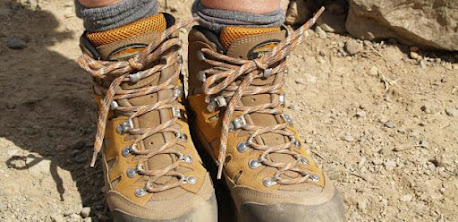Hiking advice cliché 5: Dress in layers
A number of the same 'rules' appear in every hiking advice and guideline. They certainly make sense and are a great starting point for beginning hikers, but by virtue of being short and simple they tend to cut out a lot of nuance. In this series of blogs, I'd like to provide a more nuanced view - because from the experience and knowledge I gained over the years, I learnt that the issue of outdoor safety is just not that simple. Today, the last in this series of blogs: hiking advice cliché nr 5, "Dress in layers".
Chosing the right clothing for your outdoor adventures is vital. It's the difference between between getting soaked and staying dry, between being comfortable and miserable, and if you get it wrong it can even pose a serious threat to your safety. There are countless stories about hikers who died or almost died of hypothermia, for the main reason that their clothing wasn't suited for the conditions they encountered. One famous and tragic example is the passing of Ido Keinan, a young Israeli man, on the Laugavegúr trail in Iceland back in 2004. He left the Landmannalauger hut lightly dressed on a June morning (against the advice of the wardens), on his way got disoriented in a severe snow storm, got hypothermic, was still able to contact his sister who called Search and Rescue, but sadly he passed away before the team could locate him. Today, the memorial his family built still stands on the place his body was found - tragically just one kilometer from the next mountain hut.
Your clothing should allow you to deal with all the possible conditions you can encounter on your trip, whether that's a snow storm or long lasting rain (hypothermia actually kills more people in wet and windy conditions than in snow). Good hiking clothing for the mountains does three things: it wicks away moisture from your skin, it isolates you from cold and it protects you from wind and precipitation. Instead of, for example, taking a big jacket that is both warm and waterproof, "dress in layers" advices you to split up your clothing in different layers, according to these functions. I'll explain the system for you, using some examples.
 |
| Back in 2014, I also experienced a summer snow storm in Iceland. Unexpected, but no problem in warm clothes and waterproofs. |
 |
| The same trip, much warmer weather. I'm the one wearing the blue t-shirt. |
So, what are these layers? Typically, they consist of a base layer that wicks moisture away from your skin, a middle layer that isolates you from cold, and a breathable shell layer that shelters you from rain and wind. For example, a good set for a typical day in the Icelandic summer, that on avarage is cool, wet and windy: hiking pants/leggings and waterproof pants, and a wool or synthetic longsleeve, thin jumper and waterproof jacket. Feeling too hot because you're climbing a mountain, or it's a sunny day? Avoid getting sweat-soaked by removing a layer or two. Getting cold because the temperature drops, or you're taking a break? Put on a warmer jumper (beneath your jacket) before you start to shiver. Remember, getting sweaty means being wet and cold later, and conserving heat is much easier than gaining it. In an outdoor environment, we can't control the climate around us and external heat sources to warm up by often are unavailable. So we have to carefully manage our own microclimate. Our body already does a lot of the hard work that is temperature regulation for us. Listen when it tells you that you need to adjust something, and do it at once, don't wait. Feed and hydrate your body well, too. Keeping our body at a neat 37 degrees outside takes a lot of energy.
This same layering principle can be applied to skiing/showshoeing trips. You just need more and warmer layers, especially for the times you're sitting still. Gloves/mittens/socks/hats can all be stacked as well.
The space/weight that clothing takes up is of course a consideration as well. How do you recognize a beginning hiker? They take too many clothes. I did so as well, but soon learned that two sets of clothes really is enough - more just end up damp and dirty in your backpack, and that's no use. One set is what you wear while actually hiking. Consisting of several layers, worn together this set is warm enough to still be comfortable in the worst possible conditions you could encounter. The second set of clothing consists of comfy, warm clothes to wear at night - most hikers like thermoclothing plus a down jacket. Take care to keep this second set dry: only wear it at camp and package it waterproof. You might have the opportunity to wash your clothes on the way, but if not, that's also not a problem. Muddy or dusty clothes won't harm you. You're not on the trail to look your most fabulous - let's leave that to the instragrammers. ;) As we humans have different sensitivities to cold, it takes a while to figure out what you personally need to keep you comfortable in different kind of temperatures. Get to know your own comfort zones by experimenting during day hikes from home in different conditions. Don't forget gloves and a hat!
One last tip: make sure you buy clothes roomy enough to allow for layering.
Let's end with one more photo from my Iceland trip. Because those landscapes are unbelievably beautiful and can safely be enjoyed if you're properly prepared.




Sherpa I think this is an informative post and it is very useful and knowledgeable. therefore, I would like to thank you for the efforts you have made in writing this article.
ReplyDeleteI'm glad you found it useful, Asad :)
Delete